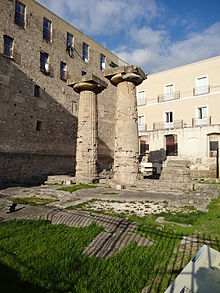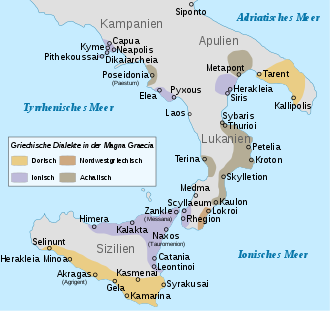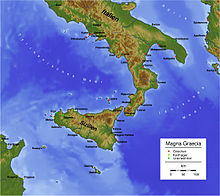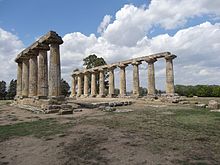Magna Graecia
As Magna Graecia ( Latin for: "Great Greece "; Greek Μεγάλη ῾Ελλάς Megalē Hellas ) the regions in ancient southern Italy , often including Sicily , are referred to, which by Greek settlers from the 8th century BC. Were colonized. Although there were always many non-Greek tribes and cities here in addition to the numerous poleis , the whole region was nevertheless strongly influenced by the Greek language and culture and was Romanized only late and slowly.
In German the area is also called Greater Greece , its inhabitants Western Greece . The Magna Graecia consisted of many populous cities; these were independent states that often fought against each other. In some cases, western Greek poles also joined forces to form Koina , in particular to form the League of Italy under the leadership of Taranto .
For the first time, the name Greater Greece for the area from Naples to Syracuse is found in Polybios . Pliny the Elder and Servius delimited the area of Magna Graecia from Lokroi to Taranto and from Cumae / Kyme to Taranto. Looking at the extent of Greek settlement and culture, the Magna Graecia extended from the environs of Naples to Sicily.
origin
From the 8th century BC The Greek colonization began in Italy. The departure of settlers from ancient Greece was often peaceful when the population of a city became too large for food production. Often the own city provided the necessary funds for the company: ships, weapons, farm implements, food supplies, seeds. Not infrequently, several cities founded a new settlement together. The exact causes and processes have long been controversial in research.
In any case, the home polis (Metropolis) gave an oikist ( founder of the colonies) the task of preparing and leading the expedition to Italy or other areas of the Mediterranean . The oikist was well known in his hometown, mostly he came from a noble family. Before the expedition he had to guarantee the protection of the gods. So he went to a sanctuary, usually that of the god Apollo in Delphi , and had God confirm the destination of his journey. God gave revelations through his priests . If the founding of the apoikie was successful, the oikist was usually venerated as a hero in his own sanctuary after his death .
Sometimes the Oikists were homeless adventurers who brought together groups from different areas in Greece and led them as navigators; sometimes they founded more than one city. And it was not uncommon for the colonists to be men who had to leave their home polis due to stasis . Usually the settlers were adult men who took local women after a while.
The Apoikien in pre-Christian times
The first Greek settlements in southern Italy emerged along the coasts, near rivers or springs, in today's areas of Calabria , Campania , Basilicata , Apulia and in the south-east of Sicily . Various cities were founded: Taranto , Kyme , Metapontion , Sybaris , Kroton , Rhegion , Paestum and Naples became the main centers of Magna Graecia. Various Greek colonies ( Naxos , Zankle and Syracuse ) were also founded in Sicily, but the Greeks, in contrast to Roman historians, mostly did not count them as part of the actual Greater Greece.
No later than the 4th century BC. The Apoikien were then referred to as Megále Hellás , Latin Magna Graecia , probably to emphasize their size compared to the Greek motherland . So the name Magna Graecia refers more to the population and culture and not to a limited political territory. The enormous prosperity of many cities also played a role, which was mainly due to the fact that the conditions for growing grain were more favorable here than in mainland Greece.
After the Pyrrhic War , the Greek southern Italy was until 272 BC. Conquered by the Romans and actually annexed by the republic , although most of the Poleis initially remained de iure independent. After the First Punic War , Sicily became the first Roman province, initially excluding Syracuse, which only lost its freedom in 211. After the annexation of the Magna Graecia, the Greek-speaking population was largely Romanized over the centuries, with the exception of small remnants in remote areas . However, this process was very tedious: Greek inscriptions were set in many cities in Sicily as early as the 2nd century AD.
Important settlements


Many of the Greek foundations quickly became powerful and rich, for example Kapuê ( Capua ), Taranto , Neapolis (Νεάπολις, Naples ), Syracuse and Sybaris (Σύβαρις).
Calabria
In Calabria these are the following cities:
- Hipponion (Vibo Valentia)
- Kaulon Monasterace
- Krimisa (Cirò)
- Croton (Κρότων, Crotone)
- Laos (Santa Maria del Cedro)
- Lokroi (Λοκροί, Lokri)
- Medma (Rosarno)
- Metauros (Gioia Tauro)
- Petelia (Strongoli)
- Rhegion (Ρήγιον, Reggio di Calabria)
- Sybaris (Σύβαρις, Sibari)
- Temesa (Nocera Terinese)
- Thurii (Θούριοι)
Campania
In Campania these are the following cities:
- Dikaiarcheia , Roman Puteoli (Pozzuoli)
- Elea , Roman Velia (Ελαία, Ascea)
- Kyme (Cuma)
- Neapolis (Νεάπολις, Naples)
- Pithecusae (Ischia)
- Poseidonia (Paestum)
Lucania
In Lucania these are the following cities:
- Herakleia , Roman Heraclea (Policoro)
- Metapontion , Roman Metapontum (Μεταπόντιον, Metaponto)
- Pistoicos (Pisticci)
- Pyxous , Roman Buxentum (today Policastro Bussentino, district of Santa Marina)
- Siris (Nova Siris)
- Troilia , Obelanon (Ferrandina)
Apulia
In Puglia these are the following cities:
- Kallipolis (Gallipoli)
- Taras , Roman Tarentum (Taranto)
Sicily
In Sicily these are the following cities:
- Akragas (Άκραγας, Agrigento)
- Akrai (Palazzolo Acreide)
- Gelas (gela)
- Herakleia Minoa
- Himera (Termini Imerese)
- Kamarina
- Kasmenai (Comiso)
- Katane (Catania)
- Leontinoi (Lentini)
- Lipari
- Mègara Hyblaea
- Mylae (Milazzo)
- Naxos
- Panhormos ( Palermo )
- Selinus (Selinunte)
- Syrakusai (Συράκουσαι, Syracuse)
- Zankle (Messina)
Other regions
Settlements in late antiquity and the Middle Ages
With the beginning of the Christianization of southern Italy (in the 3rd / 4th century), Greek regained importance as the language of the church. Since the 6th century, when Ostrom controlled the island, Greeks came from the eastern Mediterranean, from the Balkans, the Middle East and North Africa to southern Italy .
Later it was Basilian monks who were on the run from the iconoclastic laws of the Byzantine emperors. The so-called picture dispute forbade them to paint icons , the economic basis of the order. In Apulia, the displaced Greek monks hid in the gorges of the Murgia and founded cave settlements and churches there. The more than 500 cave and grotto churches are among the sights of the hinterland of Taranto and the High Murgia. The largest even have a five-aisled floor plan. The rock-hewn churches are still in a relatively good state of preservation and are partially decorated with colorful frescoes that belong to the circle of images of the Byzantine rite . The monastic life in the cave settlements has not infrequently led to the founding of canyon cities that emerged immediately above. The most important and worth seeing are Massafra , Gravina, Grottaglie and above all Matera in Basilicata .
Griko
Even today, there is a small minority in Calabria and especially in Salento in Apulia who speak Griko - a language with ancient Greek , Byzantine-Greek and Italian elements.
See also
literature
- Luca Cerchiai (among others): The Greeks in southern Italy. Searching for traces between Naples and Syracuse . Theiss, Stuttgart 2004, ISBN 3-8062-1845-5
- Martin Dreher: The West Greeks: other Greeks? . In: Gymnasium 116, 2009, pp. 519-546.
- Furio Durando (among others): Magna Graecia. Art and culture of the Greeks in Italy . Hirmer, Munich 2004, ISBN 3-7774-2045-X
- Hansgerd Hellenkemper (Hrsg.): The new world of the Greeks. Ancient art from southern Italy and Sicily . Zabern, Mainz 1998, ISBN 3-8053-2498-7
- Mario Lazzarini: La Magna Grecia. Scorpione Editrice, Taranto 1990, 1995. ISBN 88-8099-027-6
- Dieter Mertens : Cities and Buildings of the Western Greeks. From the colonization time to the crisis around 400 BC . Hirmer, Munich 2006, ISBN 3-7774-2755-1
- Norbert A. Przesang: Magna Graecia, The Greeks in Lower Italy and Sicily. Handbook for study travelers and students. Projekt-Verlag Cornelius, Halle 2009, ISBN 978-3-86634-832-5




